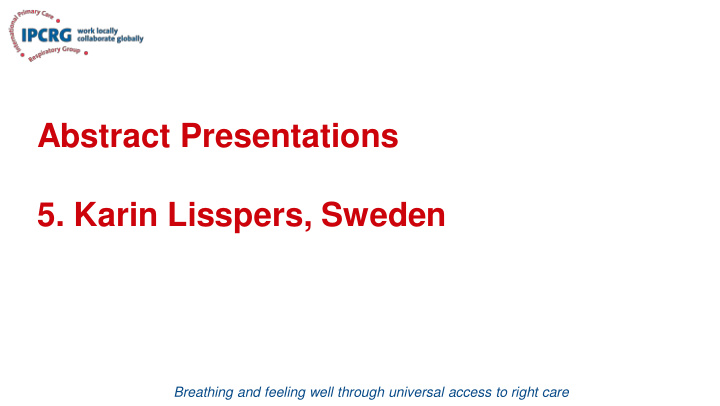



Abstract Presentations 5. Karin Lisspers, Sweden Breathing and feeling well through universal access to right care
Predicting hospitalization of Swedish patients due to COPD exacerbation with machine learning. Presented by: Karin Lisspers, Uppsala university karin.lisspers@regiondalarna.se Karin Lisspers 1 , Björn Ställberg 1 , Kjell Larsson 2 , Christer Janson 1 , Mario Müller 3 , Mateusz Łuczko 3 , Bine Kjoeller Bjerregaard 3 , Gerald Bacher 4 , Björn Holzhauer 4 , Pankaj Goyal 4 , Gunnar Johansson 1 1 Uppsala university, 2 Karolinska Institute, 3 IQVIA, 4 Novartis Pharma AG Breathing and feeling well through universal access to right care
Disclosure Declaration of Interest: KaL, BS, KjL, CJ and GJ are members of the steering committee on the ARCTIC study, which is funded by Novartis. KaL and CJ have during last five years participated in educational activities and lectures with AstraZeneca, Novartis, TEVA and Chiesi and advisory boards with AstraZeneca, Novartis, Boehringer Ingelheim and GlaxoSmithKline. BS reports receiving funding from AstraZeneca, Novartis, Boehringer Ingelheim, GlaxoSmithKline, Meda, Teva, and Chiesi outside the submitted work. KjL has during the last five years served in an advisory board and/or served as speaker and/or participated in education arranged by AstraZeneca, Boehringer Ingelheim, Chiesi, GlaxoSmithKline, Orion, Novartis, Mylan, Sanofi and Teva. GJ served on advisory boards arranged by AstraZeneca, Novo Nordisk and Takeda. GB, BH, PG are employees and shareholders of Novartis. MM, ML, BKB are employees of IQVIA. IQVIA have received funding from Novartis to conduct the study. 3
Background, rationale and objectives Background Rationale/clinical need • COPD exacerbations negatively • Tools that predict impending exacerbations impact disease severity, could be used for pre-emptive intervention progression, mortality and may to prevent exacerbations and thus improve lead to hospitalizations. long-term COPD outcomes. Study objective • To develop a model that predicts short term (within 10 days) risk factors for hospitalization due to severe exacerbations of COPD, using Swedish patient level data. 4
Study design The ARCTIC dataset Patient population • Large retrospective cohort study in Sweden spanning a time period between 2000- 2013 1,2 . • Data extracted from electronic medical records (EMR) from 52 primary care centers and linked with national health registries. • Most COPD patients are treated in primary care in Sweden. Study time period Lookback period (≥365 days) Prediction period 2000 Jun 2005 Jun 2006 or later Oct 2013 or before 10 days 10 days 10 days 10 days Data before 2005 was used for Data from 2005 contains data from “whole patient history” features. National Prescribed Drug Register. 10 days 10 days 10 days Observation period Identification period for COPD diagnosis 1. Lisspers K et al. Economic burden of COPD in a Swedish cohort: the ARCTIC study. Int J Chron Obstruct Pulmon Dis. 2018;13:275 ‐ 285. 5 2. Lisspers K et al. Gender differences among Swedish COPD patients: results from the ARCTIC, a real-world retrospective cohort study. NPJ Prim Care Respir Med. 2019;29(1):45.
Methods Model selection Prediction factors • Following methods were tested: Patient demographics • 1. Logistic regression History of previous exacerbations • 2. Random forest Comorbidities • 3. Gradient Boosted trees Medications • Laboratory tests and measurements Final model (Gradient Boosted trees) was selected • Contacts to the healthcare system using cross-validation on the training data. • Seasonal variables Validation • All models were developed on 75% of cohort (5,867 patients) and validated on the remaining unseen 25% of cohort (1,956 patients). • Validation analyses showed superior predictive performance as compared to a random classifier : • AUROC score = 0.86 (compared to AUROC = 0.50 for a random classifier ) • AUPRC score = 0.08 (12.5 times more effective than a random classifier ) AUROC=Area Under the Receiver Operating Characteristics; AUPRC = Area Under the Precision-Recall Curve 6
Results Previous severe exacerbations* are prediction factors for future COPD hospitalization Proportion of records with severe Top most important prediction features exacerbations* 10 days after prediction point 100% 80% 1. Number of severe exacerbations* (last 180 days) 60% 40% 2. Number of severe exacerbations* (whole history) 20% 3. First COPD diagnosis as outpatient 0% 0 2 4 6 8 10 12 14 16 18 20 22 24 Number of severe exacerbations* before prediction 4. Number of COPD related healthcare contacts point per patient (whole history) Severe Exacerbations, 1-180 days before prediction point Severe Exacerbations, all time before prediction point 5. Charlson Comorbidity Index (CCI) The risk for hospitalization within the next 10 days 6. First COPD diagnosis as inpatient increases with the number of previous severe exacerbations*. * Severe exacerbations were defined as exacerbation where a hospital stay was required.
Conclusions Clinical information on patients’ history from EMRs and national registries can predict severe exacerbations (hospitalizations). To identify patients at risk of severe exacerbations focus consultations on: • History of exacerbations • Setting of first COPD-diagnosis • COPD-related contacts to healthcare system • Comorbidities 8
Recommend
More recommend